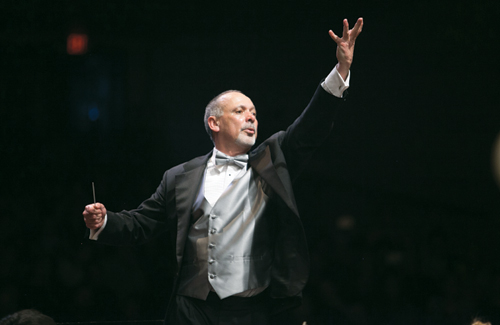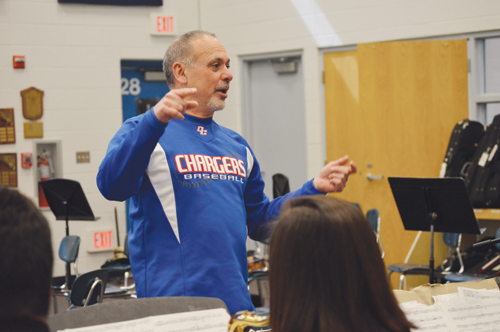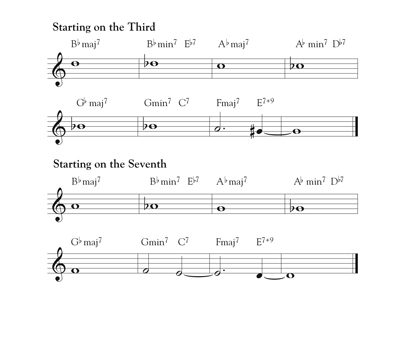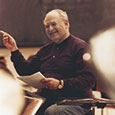
On May 11, 2016, at Hemmens Auditorium in Elgin, Illinois, I witnessed one of the most thrilling and rewarding experiences of my musical life. After 34 years as an extraordinary music educator, Mark Bettcher conducted his final concert before retiring from Dundee-Crown High School. As he took his first few steps from the wings onto the stage, 1,000 people rose in unison and gave him an outpouring of love and respect rarely seen or felt. This was a whole community of current and former students, parents, and followers of this man’s career saying thanks.
I first met Mark in the fall of 1980 when he became my teaching assistant at Northern Illinois University. He was a wonderful trombonist and a fine composer and arranger. At least once a year for all 34 years of Mark’s teaching career, I observed him working with his students. I was constantly blown away, not only by his musical expertise, but with his rapport and communication skills with all age groups.
Mark’s development of the orchestra program was ever present when at this final concert his freshman concert orchestra performed Saint-Saëns’s Bacchanale from Samson and Delilah. His top orchestra performed Verdi’s La Forza Del Destino overture, Pavane by Faure, and the Fourth Movement of Dvorák’s New World Symphony.
I recently sat down with Mark Bettcher to review his remarkable legacy and find out how he succeeded in so many areas of music education.
How prepared did you feel as you began your first teaching job?
My plan was to move to New York and play for a living, so when my wife wisely suggested that I take a teaching position so we could save some money for the move, I accepted a job teaching elementary band. Most of my music education degree was geared toward teaching high school. It had been several years since I took instrumental methods, so I was woefully unprepared to teach all of the instruments to beginning band students. Fortunately, I was directed to a wonderful teacher in the same school district named Thom Robertson. One of the reasons I have always been a preparation guy is because of the two weeks I spent with Thom before school started. He gave me a good idea of what to expect and how to prepare, and also shared valuable supplemental materials for the various instruments. I am forever grateful for his wisdom, mentorship, and gracious willingness to help a clueless rookie.
My first group lesson was held in the boiler room of Kings Road Elementary School. There were 15 5th graders eager to receive their rental clarinets and a lesson on how to play. I passed out the instruments the music vendor delivered that morning and asked the students to put their cases on their laps. I then said, “everyone open up your case.” Suddenly there were clarinet parts all over the floor. Over half of the students had their cases upside down so we spent the rest of the lesson sorting things out. Needless to say I was frustrated at the time, but looking back it was a very valuable lesson for me. I realized preparation is key, and that you could never be prepared enough.
After two years of teaching 5th grade band you were assigned to Carpentersville Middle School, where you taught strings and jazz band. What were the challenges you faced?
The first challenge I was given was to grow a string program in an economically challenged school that the administration was threatening to cut due to low numbers of students. When I arrived there were 12 to 15 students who were embarrassed to play in front of their peers. If you only have a dozen players on rental quality instruments it is going to be a thin sounding group no matter how well they play. I had to get the numbers up quickly so the group sounded full and we could justify keeping the program. It didn’t take long. I worked really hard to recruit string players from the elementary schools. I did everything feasible to get kids to play strings.
The second challenge was that I was not a string player and had little time to prepare. The job included the middle school and three feeder elementary schools, so I needed to become literate quickly to teach beginning strings. Once again, I went to a friend who was a great violinist and teacher at a nearby school. Gerry Romack was a lifesaver and helped me immensely. Gerry alleviated some of my anxiety regarding the string world (which I continued in for 32 years) when he explained that although I couldn’t play string instruments proficiently, all of the tenets of great string playing are readily observable. There are no abstractions as there can be with a wind instrument where you are trying to find out what is going on in someone’s body. Tone production, technique, and dexterity are the keys. Gerry provided me a solid foundation about correct posture and string pedagogy. All I had to do was pass this valuable information along and insist that my students comply.
How did you decide on repertoire for your string players?
Repertoire is key for building technique. In Carpentersville back then there were no Suzuki programs feeding into the schools. After research and consultation with colleagues, I determined the skills I wanted my sixth grade violinists to have. I wanted them to play in first and third position accurately with a solid left hand position comfortable enough to begin playing with vibrato. I wanted them to have a solid bow hold flexible enough to play with a strong sound and also off the string. I looked for pieces that required those skills, great pieces of music that also facilitated learning.
How did you and John Gorman divide up your work over the years at Carpentersville Middle School and Dundee-Crown High School?
John (Doc) Gorman is a fantastic teacher, excellent musician, and great friend. We have sharply contrasting personalities that meshed together really well. Our strengths and weaknesses are perfectly different, but we share a common belief in doing whatever is best for students. We had an immediate feel for what we were doing.
Carpentersville Middle School did not have a jazz band before I arrived so Doc and I started one. We had a great time starting at zero. The first year we didn’t have a drum set player in the entire school. I can still see Doc sitting on the floor working the feet of one of my cellists who volunteered to give it a try. It was a great learning experience. When team teaching the jazz band we had our roles that worked extremely well. Doc is a great trumpet player and transposer, so he played along with the trumpets, trombones and saxophones while I ran rehearsals. Those middle school bands played with such a mature feel because they had a great aural example coming from Doc that gave life to the verbal instruction. He is also fantastic with technology and sound reinforcement, so we always had professional level equipment.
We decided together that a healthy instrumental program would have about 2⁄3 band students and 1⁄3 orchestra. It is bit more orchestra heavy now, but the notion that we decided things together is just one example of how our relationship was never competitive. We always considered how to help each other, which directly benefited our students. I cannot tell you how valuable that true sense of teamwork is. It is so rare to go into a school or department and really feel that. In too many places everybody does their own thing. When you work together you can be twice as effective for students.

In my experience in hundreds of clinics, I found that ensemble playing was often stronger than the improvisation. Discuss your unique approach to teaching improvisation.
I agree that ensemble playing is way ahead of improvisation. I had a real epiphany about teaching improvisation a few years ago. After attending a clinic by the great electric bassist Victor Wooten, I decided that if I really believed that jazz was a language, my approach missed the boat. First, I had to identify my target audience. The reality is that a high percentage of our students are predominantly visual learners. Most of what they are exposed to in school is completely counterintuitive to learning aurally. There are no sections on the ACT test that measure the ability of students to mimic, memorize, process, and manipulate aural information. Since the education community has completely bought into standardized tests as a measuring stick for success, our core curriculum is designed to develop reading expertise while aural skills are seriously neglected.
How is it that many of our children become relative language virtuosos by age four while very few students become fluent in either foreign language or jazz improvisation from studying in school? The most obvious answer is immersion. Infants learn to communicate because they are completely surrounded by language and require a certain mastery to fulfill basic needs. The plight of foreign language and jazz educators is that it is impossible to create total immersion in a school. While none of us can mandate that students immerse themselves in the jazz language, I developed some effective language-based strategies and activities that facilitate fast and relatively stress-free results for visual learners. These positive initial experiences with improvisation have motivated a greater percentage of my students to surround themselves with a steady diet of listening to the jazz masters and copying, memorizing, processing, and manipulating. They learn the language in an authentic way.
One of the most important components is choosing the right songs for early improvisers. Most of the jazz aids use songs like Impressions or So What for beginners because the harmony is relatively static. The idea is that fewer chords makes it easier. My contention is that when the harmony is static the improviser must generate all of the development and movement. Mastery of the scales or modes used in these tunes is essential before students can execute developmental soloing. Most early improvisers are not fluent enough with scales and modes to construct coherent solos, so they become frustrated or embarrassed because they are initially unsuccessful. This makes them significantly less likely to pursue the jazz language at its source.
Carefully chosen songs based on chord changes that move more frequently provide a directional framework that can help young improvisers develop coherent improvised solos relatively easily. Guide tones are the notes that form the basic sound quality of a particular chord. They are always the third and seventh but frequently in jazz (especially bebop) may also include other chord tones (b5, #5, b9, #9). Joe Henderson’s Recorda Me is an excellent song to illustrate using guide tones to provide a simple descending line that students can use to develop solos. I construct a visual aid (guide tone sheet) starting on either the third or the seventh of the first chord in the last eight bars of the song that creates a chromatically descending whole note melody that really defines the harmony of that section of the tune.

Embellishing one note per bar with stylistically appropriate rhythm and articulation reduces the amount of information, simplifies the process, and facilitates virtually instant success. I have found that initial success with jazz improvisation makes it much more likely that the students will learn the language authentically by immersing themselves and listening.
How do you explain the effect that your program had on the entire community?
One of the many things I learned from you is the importance of enlisting the people around you and developing a true sense of community to maximize your resources. We frequently brought in guest artists and the Northern Illinois University jazz ensemble, and we hosted a jazz festival every year. These became big community events and attracted other folks who were altruistic enough to help. I have brought in all sorts of private teachers to give private lessons at much less than they would typically charge. The impact of that and also playing 40 or 50 events each year with the jazz ensemble and many more with the chamber orchestra gave us a place in the community.
What is an average day like at Dundee-Crown?
I usually arrive between 6:00 and 6:15. It is my only time to practice. After I check email, I get into my warm-up routine. I might work on a piece that I am writing or play as students filter in. It is a good for students to see that I am still passionate about playing music. After that, I might go down to the middle school before my first orchestra, and work with the two jazz bands. I make an appearance so those students all know me.
The first class that I teach is freshman orchestra, which lasts 45 minutes. That is followed immediately by my top jazz band. Then I have my top orchestra. I team teach the second orchestra, which directed by my associate. I might run a sectional during that. I will go down and help the band director, Melissa Aukes, who is also a former student of mine, with her second band. By then it is about 2:30 and time for lunch. After school there is usually some sort of jam session, or there will be rehearsals during musical season. Over the years I never taught less than 60 hours a week and in April and May, the total is 70 to 80. My day is kinetic and busy, but it is never work. It is who I am.
Now that you have semi-retired, what are your plans?
This first year I am working as a music teacher coach throughout the district. I will work up to 100 days. Anything that someone wants me to work on with them, I will. If they want me to work with their students, I will. Teachers can request help with something like jazz improvisation, and I can set up a program to work with them for several days. I am excited about that.
I am working on a textbook that has a lot of the jazz improv exercises that I use. I have written 12 original songs based on the movie Casablanca that I am working with a collaborator to flesh out into a musical. I also have enough original material that I have written for a couple of CDs. Even in retirement, I expect to stay busy.
* * *
Mark Bettcher’s Final Concert
Jazz Ensemble I
Corner Pocket by Freddie Green
Groovin’ High by Dizzy Gillespie/Mark Taylor
Little Gus by Paul McKee
I’ve Got You Under My Skin by Cole Porter/Mark Taylor
Strap Hangin’ by Michael Brecker/Vince Mendoza
I’ve Gotta Right to Sing the Blues by Harold Arlen/trans. Jeff Lindberg
Friends Again by Lanny Morgan
Salt Peanuts by Dizzy Gillespie/Mark Taylor
Intermission
Concert Orchestra
Bacchanale from Samson and Delilah by Saint-Saëns/Isaac
Symphonic Orchestra
Finale from 5th Symphony by Beethoven/Woodhouse
Chamber Orchestra
La Forza Del Destino Overture by Guiseppe Verdi
Pavane by Gabriel Faure
Symphony No. 9 “From the New World” Op. 95
by Antonin Dvorák
IV. Finale






